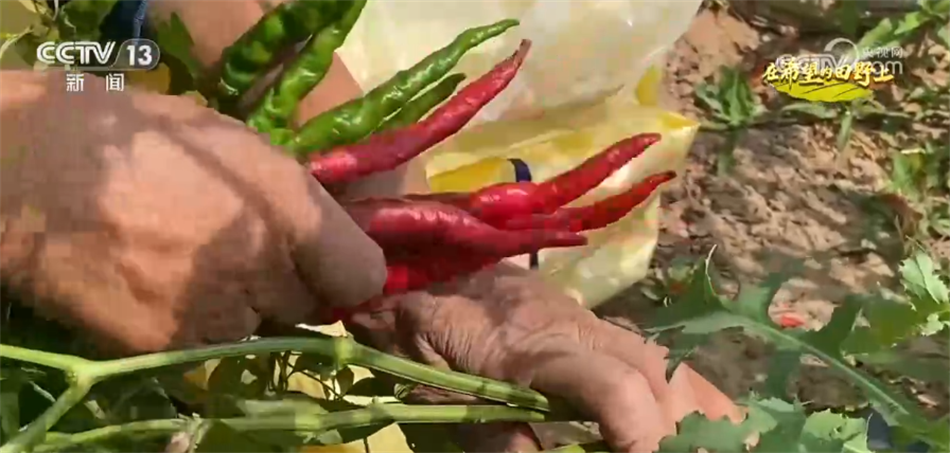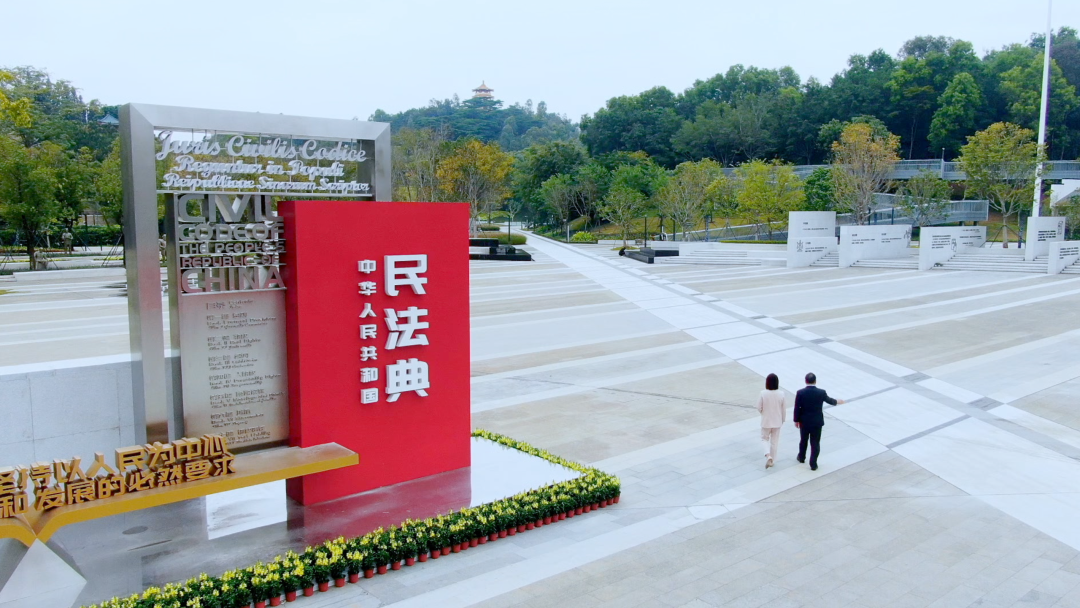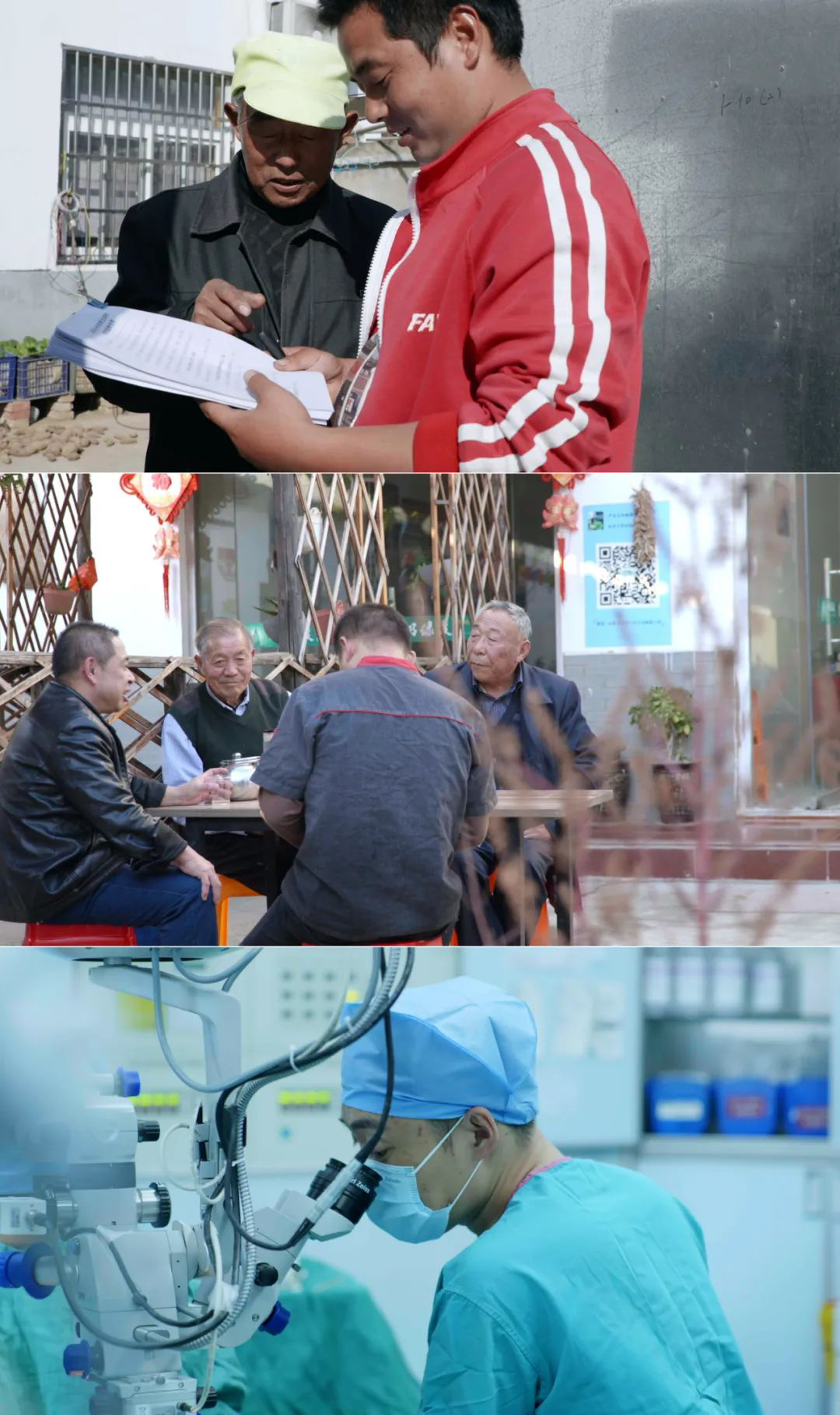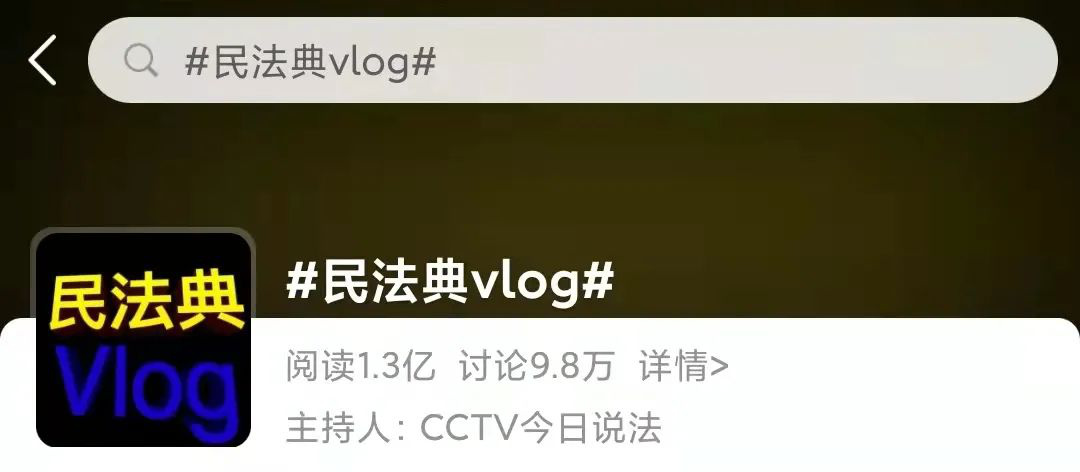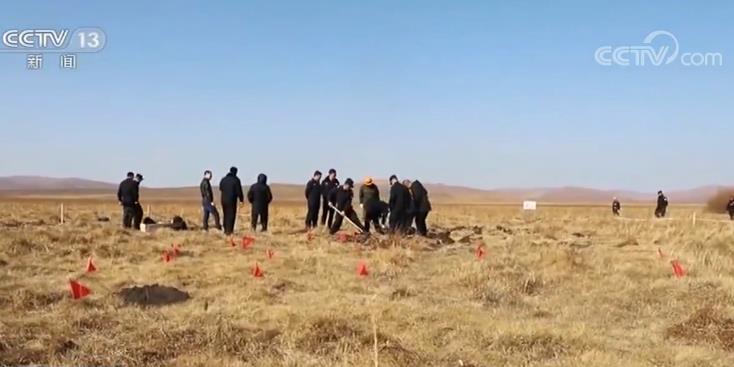Text |Xiao Mingchao-Trend Observation
In 2023, the consumer market in China experienced the process of "gradual recovery" to "normalization return" and then "steady recovery", and consumers’ life also showed a new sense of rhythm. Colorful, simple life and stable happiness became the experience of many consumers in 2023.
What new trends will emerge in China’s consumer market in 2024? How to stimulate potential consumption? How to create a new consumption scene and stimulate new vitality of consumption? How do industries and enterprises look for new opportunities from the consumption trend?
Key words of consumption trend in 2024:
"Steady progress" and "innovation"
The research on consumption trends conducted by Zhimeng shows that consumers in China are positive and optimistic about 2024, hoping to enjoy life better, grow faster and go forward bravely; At the same time, consumers are also controlling the rhythm, trying to win steadily, moving forward steadily and further maintaining rationality. In terms of consumption expenditure, everyone will put more energy into the field of physical and mental pleasure. In addition, consumers say that they will not be downgraded for the consumption of their families, healthy consumption and self-satisfaction.
Based on the observation of China consumer market by Zhimeng Consulting in 2023, the key words of the consumption trend in 2024 are "steady progress" and "to the new". "Steady progress" represents the control and grasp of the consumption rhythm. Consumers will reset their consumption desires, less and less want to be bound by the emotions that create consumption anxiety, and hope to keep their needs awake; "To be new" means that consumers are looking for spiritual enrichment through more experience and exploration, pursuing emotional value inward and exploring self-relaxation outward, which will become a new yardstick of life.
2024
Top Ten Consumption Trends in 2024
After in-depth research, Zhimeng Consulting predicted 10 major consumption trends in 2024, namely: prudence and shrewdness, self-esteem, outward exploration, fireworks narration, minimal quality, convenience and enjoyment, essence and health preservation, value reconstruction, youth experience and sustainable brand.
Trend one: prudence and shrewdness
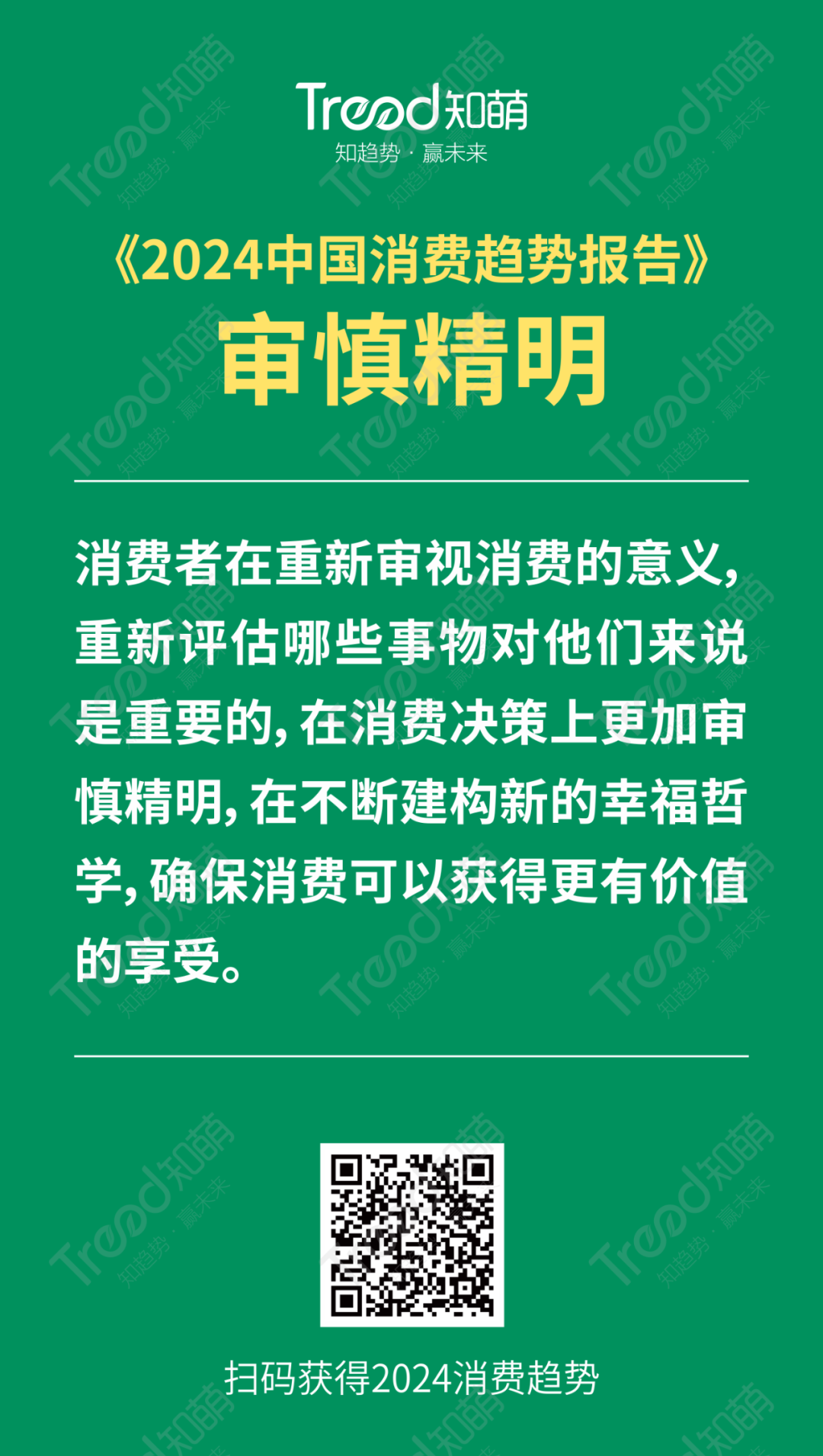
Consumers who return to normal become more rational and calm, re-examine the meaning of consumption, re-evaluate what is important to them, be more cautious and smart in consumption decision-making, and constantly construct a new philosophy of happiness to ensure that consumption can get more valuable enjoyment. Consumers are no longer blindly impulsive in shopping, and they are no longer eager for quick results. The criterion of high cost performance is no longer limited to "low price", but attaches importance to practicality.
At the same time, more and more consumers are hoarding less goods, buying only what is necessary, or even buying less and buying fine products, but it will take a long time. Consumers will be more cautious before shopping, search and compare through multiple platforms, read comments and ratings in detail, and conduct full investigation and comparison in order to pursue the certainty of consumption and seek a sense of security in life.
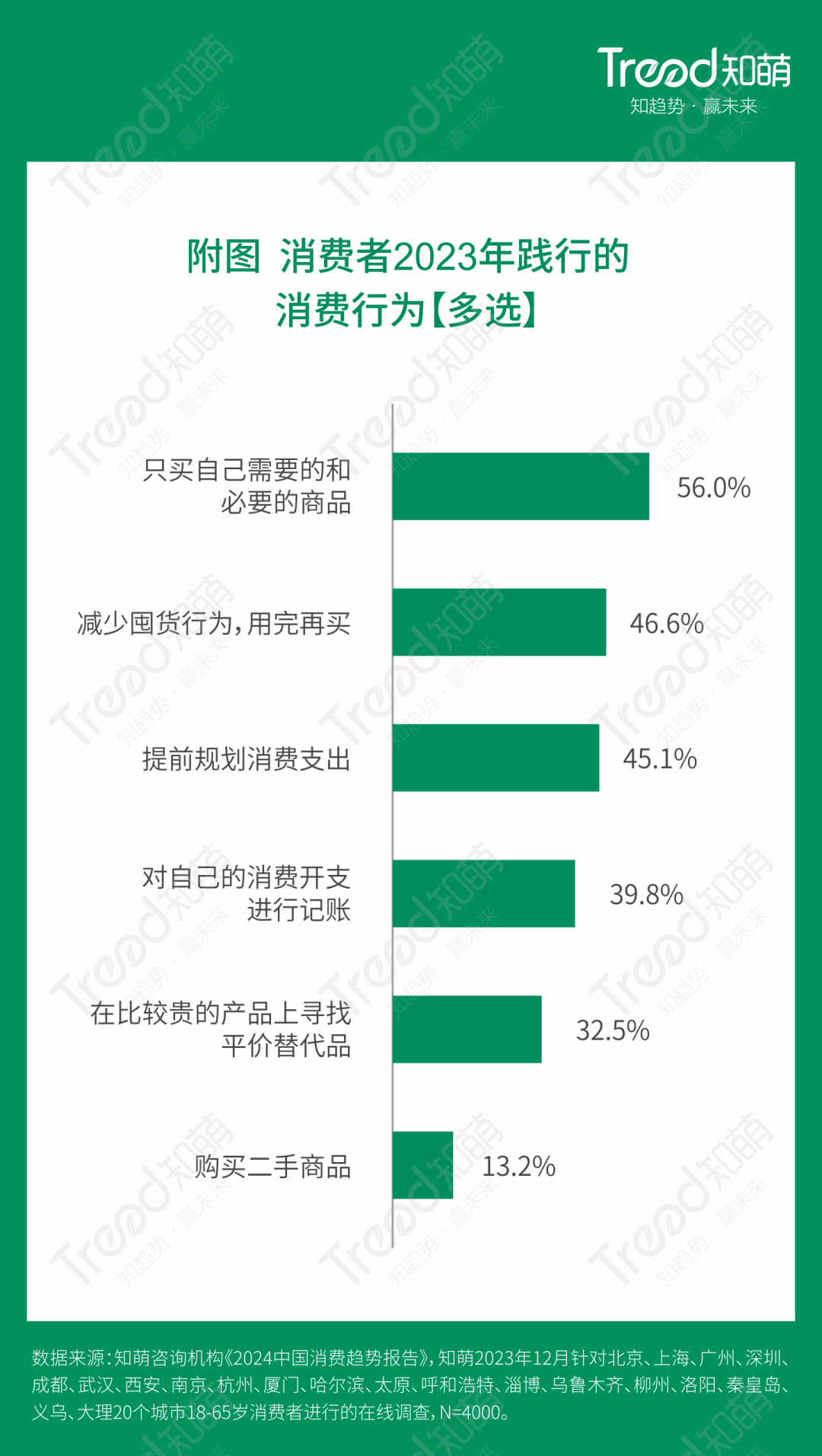
Prudence and shrewdness are particularly obvious among young people. The popularity of topics among young people, from 9.9 yuan of coffee to 10 yuan for a meal, shows that young people are also mastering the right to consume and moving towards "human sobriety". Frugality is not stingy, but a new philosophy and dignity of life.
Under the consumption trend of prudence and shrewdness, products with "extreme parity" and "high quality parity" will always be favored by consumers. For example, Decathlon, which was born in France in 1976 and entered the China market in 2003, grew rapidly in China in 2023. Its popularity lies in its extremely low price and high-quality products that can meet the whole sports scene, which meets the more rational consumption needs of consumers.
"High-quality replacement" products will also usher in opportunities, and can be used as a basis to complete the continuous advancement of the brand. For example, the cosmetics market used to be dominated by international brands. However, the domestic brand Polaiya has completed the replacement of big brands with the road of scientific and technological innovation based on the concept of "scientific formula", relatively close to the people’s price and successful core big single product strategy. Now, the customer unit price has been raised from about 100 yuan to above 200 yuan, and it is jumping from the public to the middle and high-end market.
In the face of more rational and prudent consumers, the market will de-bubble and enter the stage of removing the false from the true. Brands need to point to the real demand of consumption, give full play to the true strength of brands, show more "worth feeling", and provide consumers with a more tested quality-price ratio, a more appropriate and meticulous service experience and a more scrutinized brand value.
Trend 2: please yourself in spirit.
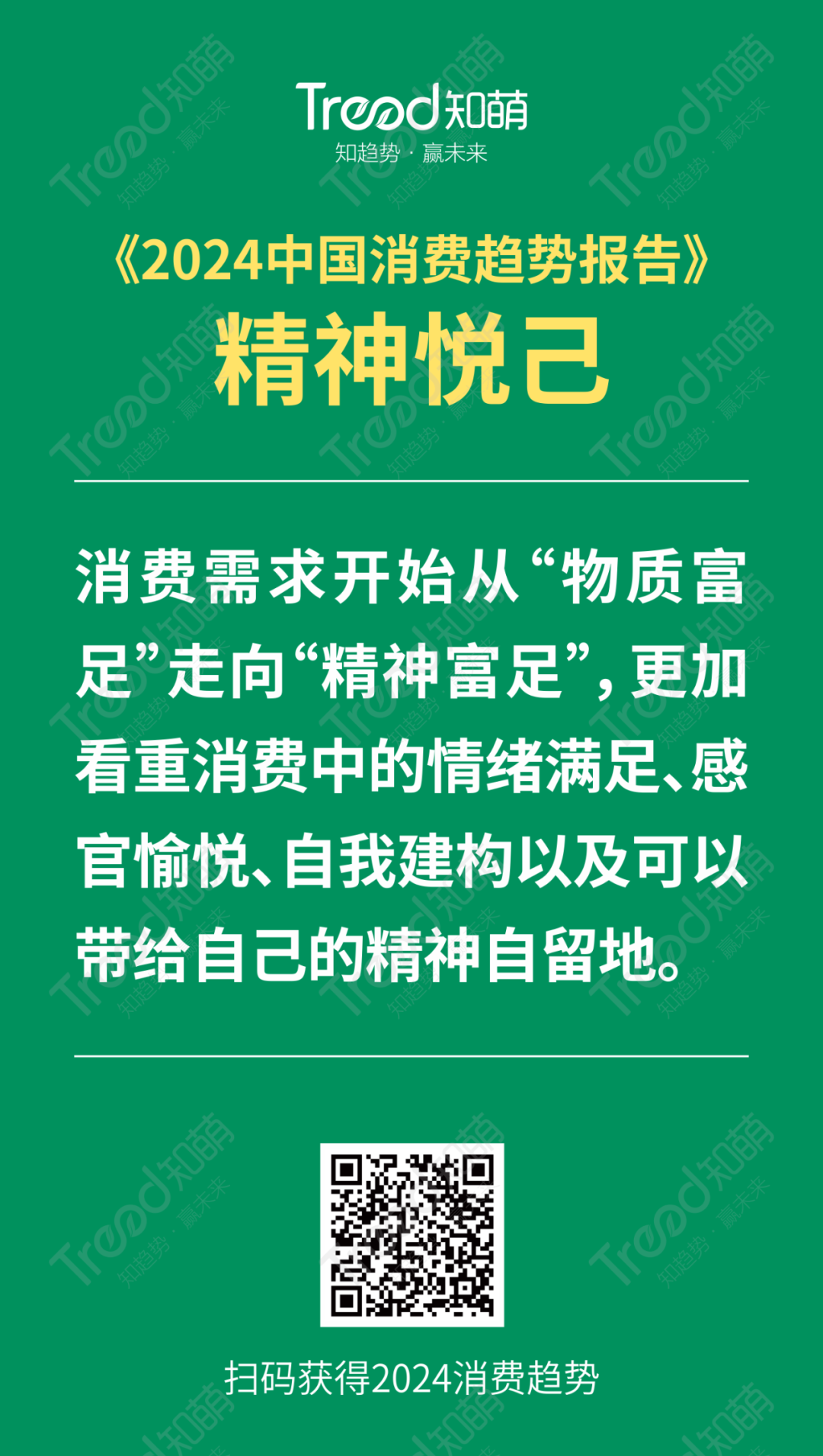
Dopamine wearing, Maillard wearing, electronic wooden fish, city walk, looking for a partner, incense in temples, "queuing stations" in lottery shops, and crazy literature in the workplace …………………………………………………………………………………………………………..
Zhimeng’s survey of consumption trends in China in 2024 shows that 64% of consumers pay more attention to spiritual consumption, and young consumers pay more attention to spiritual consumption. From the three dimensions of emotional concentration, cultural nourishment and self-enrichment, consumers begin to create a world of spiritual satisfaction for themselves. For example, if a product wants to bring pleasure to consumers, it is very important to have emotional incentives, new experiences, face value and culture in addition to the easy use of product functions.
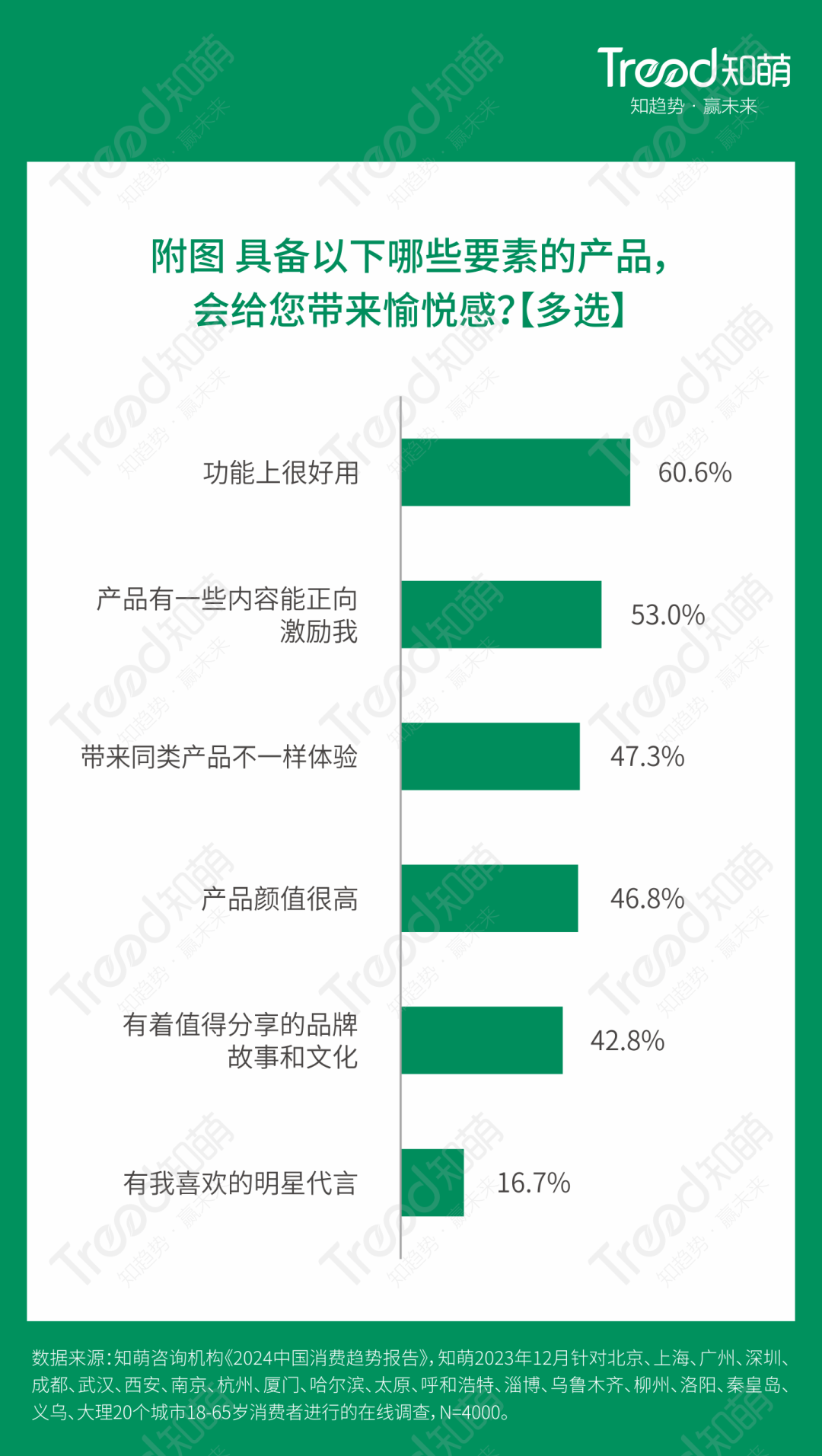
In the consumption survey in 2023, Zhimeng found that gold jewelry sold very well. Why is it hot? In the past, young people were not interested in gold. However, in 2023, Zhimeng investigated many gold jewelry stores, and found that more than 60% of their products were bought after 1990s and 1990s. They wanted to save Jin Doudou, and even bought gold as a commodity that could not only soothe the present mood, but also "save" for the future. Therefore, many brands are also launching a variety of cross-border design products. For example, Mengjinyuan, which has accumulated after nearly 30 years of precipitation, captures the emotional scenes of young people by creating national fashion products such as master craftsman series, and even shouts slogans such as "purity is higher, love you more than 100 million points" and "5.9 billion pure gold in Mengjinyuan represents pure love", attracting consumers through cute designs, such as gold shovels and other designs, and resonating with consumers emotionally.
In 2024, there will be more spiritual self-pleasing consumption. In order to seize this trend, brands and enterprises can meet consumers’ spiritual self-pleasing needs and seize the emotional consumption track from three perspectives: providing emotional value, adding cultural significance and bringing interesting experience.
Trend three explores outward.
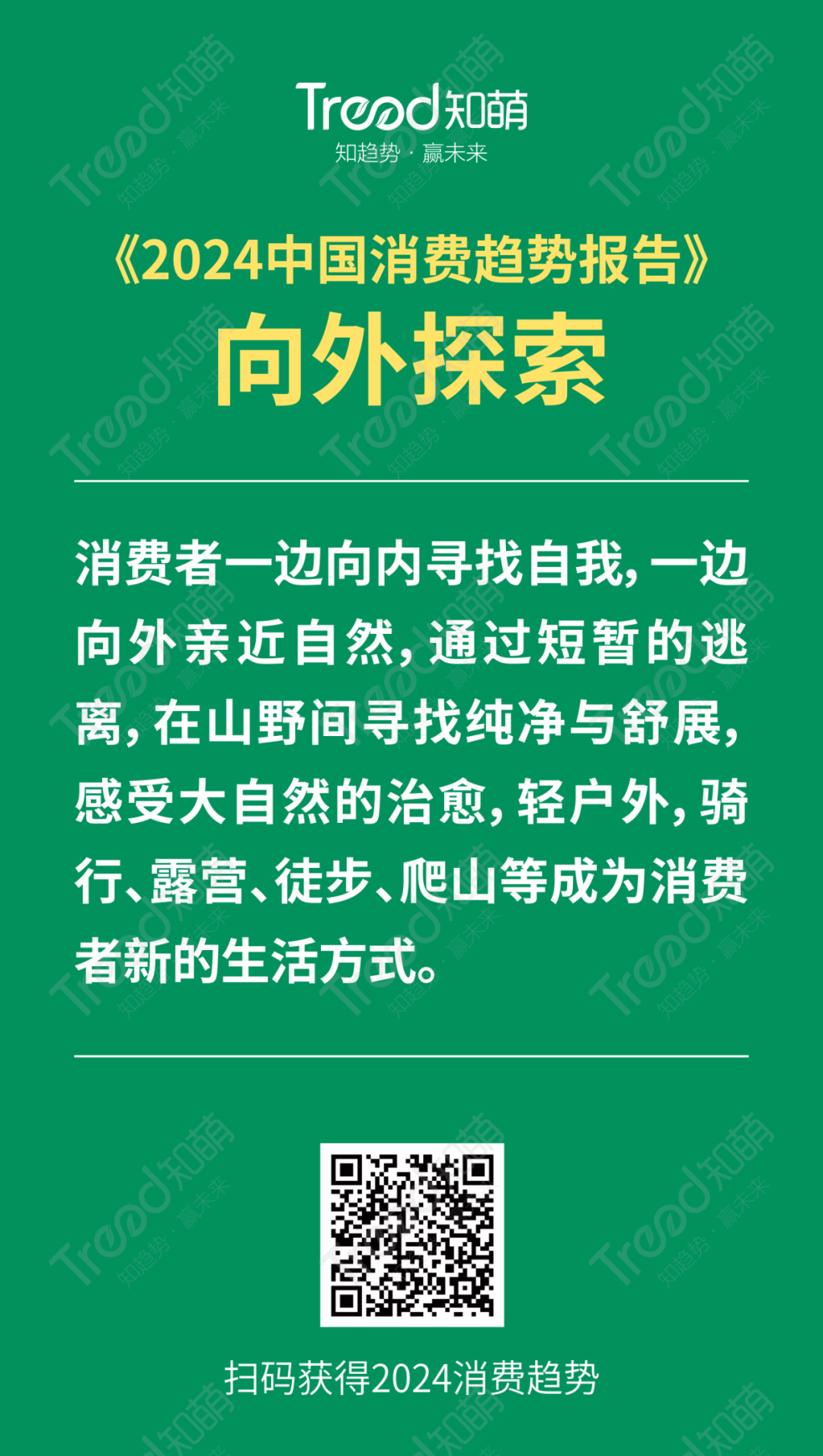
In today’s fast-paced, high-pressure society, finding an effective way to decompress has become the focus of people’s attention. Going for an outing once is not only to explore yourself, but also to meet the needs of feeling the world. In the sports mode, being close to nature, traveling lightly, relaxing and letting the outdoors become the most preferred way for consumers with its characteristics of natural healing, challenging yourself, expanding social interaction and slowing down the pace.
Zhimeng’s research on China’s consumption trend in 2024 shows that 65.3% of consumers will go out more frequently in 2023, and outdoor shows a trend of developing from the small crowd to the public.
Consumers seek for themselves internally, and get close to nature externally. Through a short escape, they seek purity and stretch in Shan Ye, feel the healing of nature, and ignore the outdoors. Cycling, camping, hiking and mountain climbing have become new lifestyles for consumers.
Outdoor sports not only show a trend from the small crowd to the public, but also have more diverse forms and degrees. From the outdoor form, it is exciting or peaceful, or going up the mountain or into the sea, or warm or cold … Consumers can choose different outdoor sports according to their physical fitness and preferences, and hiking, cycling, hiking, mountaineering and camping are the most popular among consumers. To some extent, light outdoor, professional outdoor and extreme sports have different degrees of fun. In order to go out better, consumers should have more professional equipment, which has brought the growth of the whole outdoor sports track. sun-protective clothing, jackets and hiking shoes, including quick-drying sports shoes and bicycles, have all become professional equipment subdivision tracks.
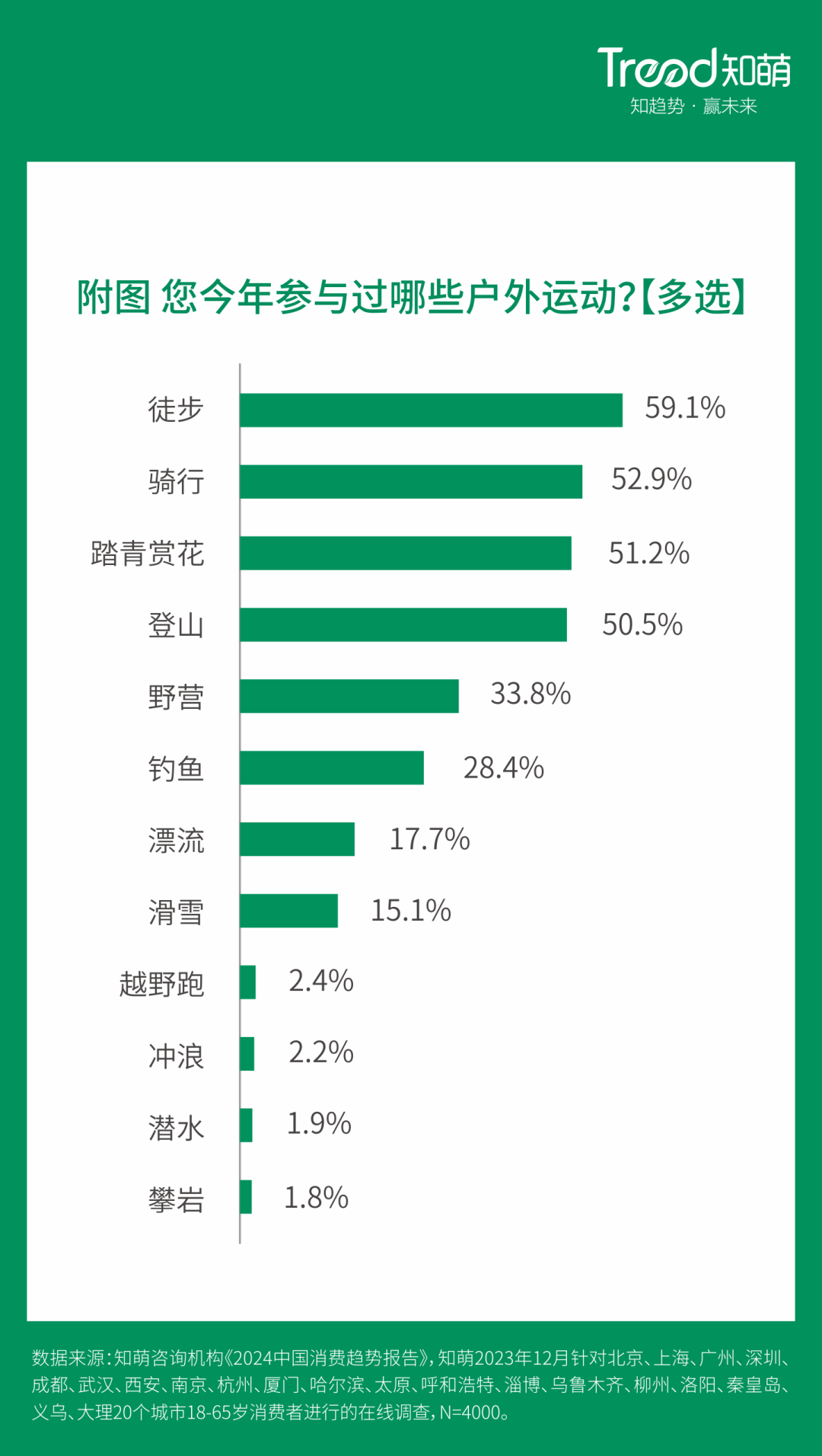
For example, Jiaoxia opened the market with a sun-protective clothing, and took advantage of the outdoor craze to upgrade from a hard sunscreen brand on the main line to a "lightweight outdoor" lifestyle brand, conforming to the trend of outward exploration. Similarly, camel has become an outdoor standard for young people with a jacket printed with camel patterns. Adhering to the brand concept of "exploring nature and self", camel inspires young people to pursue their dreams and goals, bravely face difficulties and challenges, and discover their potential and value.
Consumers like outdoor, which can promote the development of outdoor, because it meets various needs such as health, spirit, social challenges, healing, etc. Therefore, it can be said that outward is inward, outward exploration, and finally points to inward spiritual needs.
Trend 4 Fireworks Narration
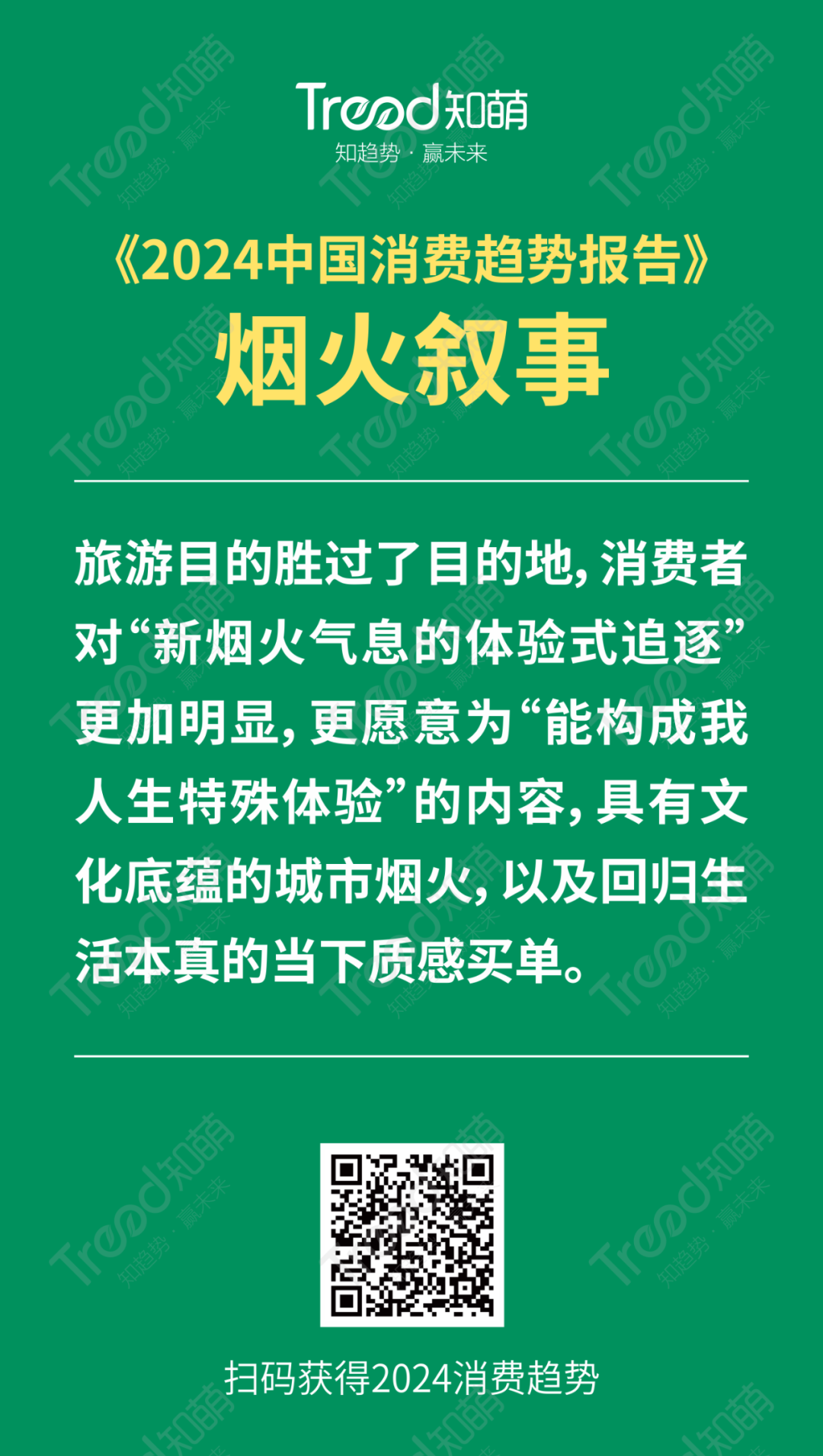
Since 2023, one of the most important keywords, tourism, will definitely rank among them. Going out to have a look has become the pursuit of more consumers in the recovery of consumption. Most consumers said that they have increased their travel consumption in the past year and plan to increase their travel expenses in the coming year.
But why do you want to travel today? Nearly half of consumers think that relaxing in travel is an important way to release stress, and "the purpose of traveling is better than the destination". This sentence has a profound meaning, and consumers are rethinking why they want to travel. Mountains, rivers and rivers are no longer the only reason to attract tourism, because what everyone pursues is a sense of relaxation in tourism. We should discover the local culture, fireworks and slow down to truly experience the humanistic atmosphere of the city. Consumers are more obvious about the "experiential pursuit of new fireworks" and are more willing to pay for the content that can constitute my special experience in life, the urban fireworks with cultural connotations and the real present quality of returning to life.

In addition to being keen on cultural tourism, most consumers also like to avoid people’s flow and travel backwards, go to a small city to seek peace and relaxation, stay away from the hustle and bustle of the city and feel more unknown surprises; At the same time, consumers are increasingly favoring the immersive in-depth experience tour with fireworks and feeling the "new pyrotechnicism" of the city.
The new firework doctrine, which preserves the cultural heritage and the smell of fireworks, meets the diverse needs of consumers, so it has also become a new password for urban traffic. Whether it is the hot "going to Zi for roasting" in 2023, or the topics and events such as BA and Cun Chao in Guizhou, which have exploded, it has opened up a new perspective for urban fireworks narrative.
Under the trend of "fireworks narration", cities should form an exclusive attraction with fireworks, make urban cultural tourism content and theme, empower cultural tourism with IP value, create new urban fields and create new scenes with fireworks as the extension; At the same time, brands can also absorb nutrients from urban culture, extract characteristic elements, and integrate them with products, thus creating new products, excavating new scenes, telling new stories and presenting brand texture. For example, Netease Travel put forward the concept of "content travel, start together". Based on Netease’s content ability, it tells the story of a small town with "good scenery", "good taste" and "good humanity" through the mode of creating content such as land, music, IP and communication. Netease Travel provides a new solution for the travel industry in the era of "fireworks narration" with co-creation and companionship.
Trend 5: Quality to Micro
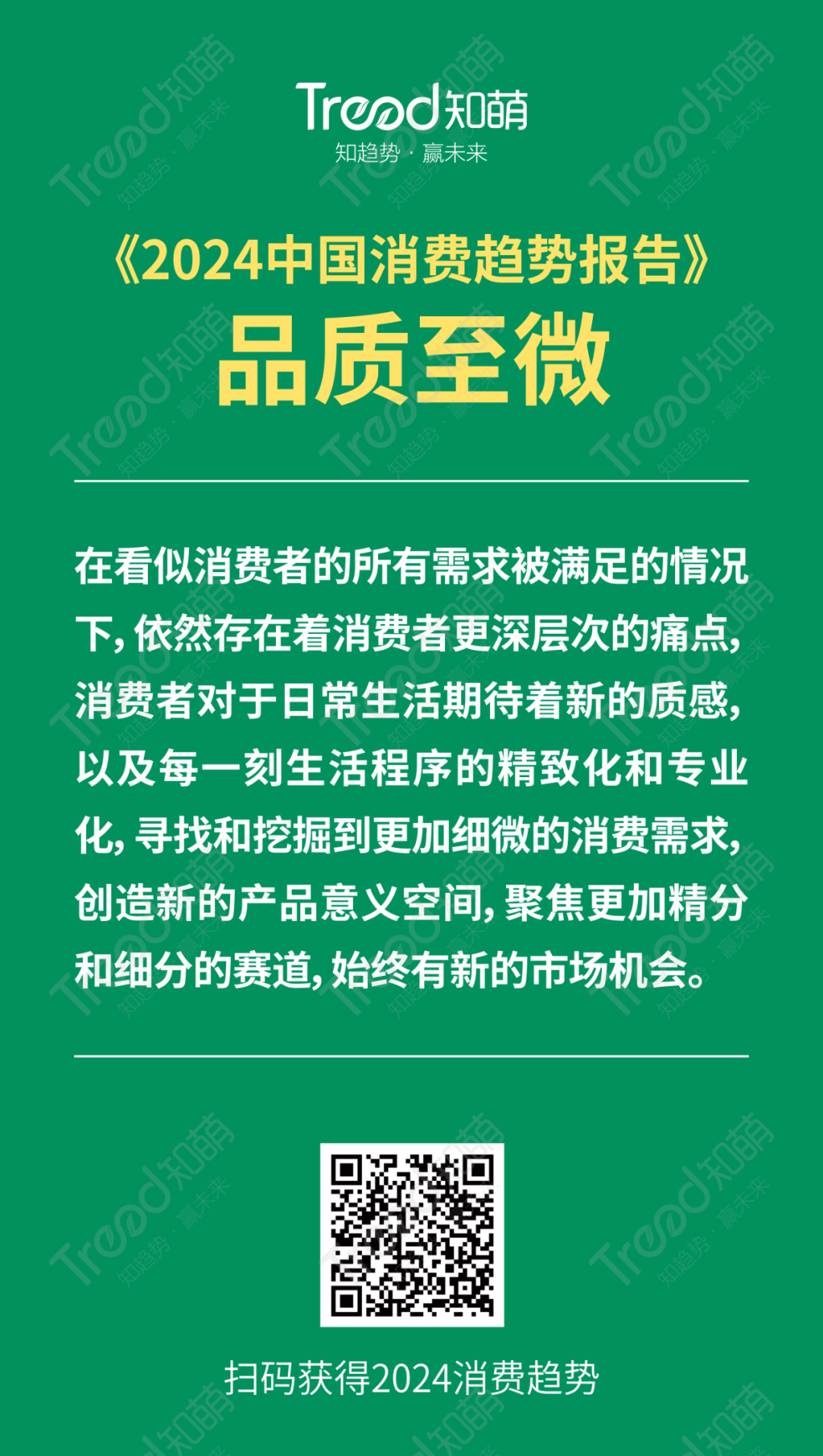
Consumers’ demand for quality life is endless. Today, with the upgrading of "quality", people are committed to seeking more efficient and professional products to solve the small pain points in life. Therefore, under the circumstance that it seems that all consumers’ needs have been met, there are still deeper pain points. Consumers are looking forward to a new texture for their daily life, as well as the refinement and specialization of their life procedures at every moment, and there are always new market opportunities to find and excavate more subtle consumer needs, create new product meaning spaces, and focus on more finely divided and subdivided tracks.
Today, we see many product scenes. For example, everyone expects that the washing machines are getting finer and finer. Many people have more than one washing machine at home, and many washing machines are needed. Today, the use of a household paper, the same points more and more fine, from toilet paper to kitchen paper, there are more scene classification, and even a daily necessities will be classified for different members of the family. Therefore, the needs of consumers in more delicate daily life scenes have become an important entry point for new categories and new brands to create markets.
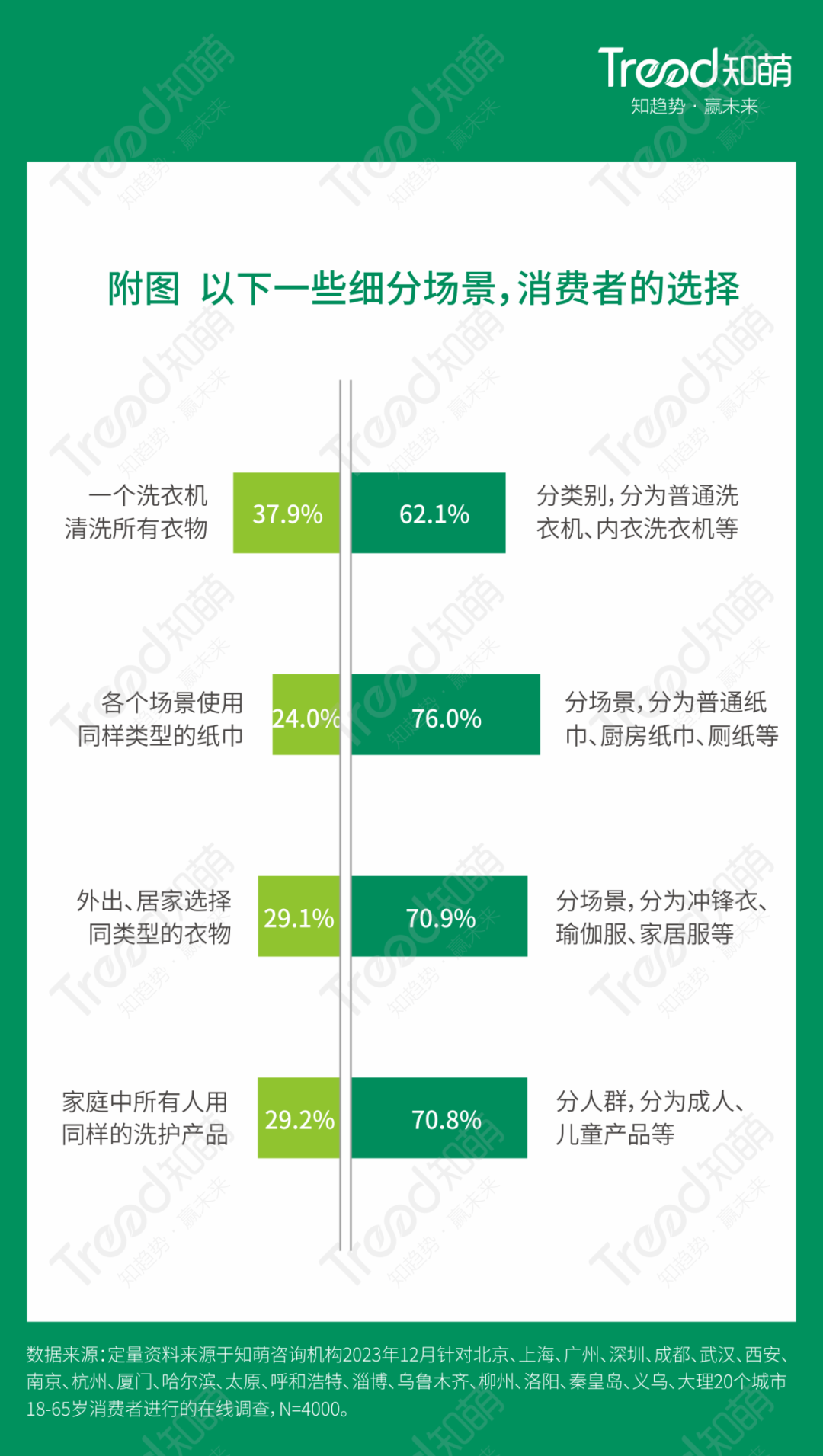
In many small scene categories of quality life, many new trend brands have emerged. For example, Deyou only spent more than a year, from focusing on the strategic positioning of "improving the clean and comfortable wet toilet paper" to launching a brand-new slogan of "All people who love cleanliness are using Deyou", to choosing Focus Ladder Media as the core position of communication under the brand line, and quickly penetrated Deyou’s brand image into the mainstream consumers’ minds, becoming an undisputed industry leader and leading the city mainstream people in the time window of leading the brand cognition vacuum in the wet toilet paper market.
In the field of fierce competition, we can still win the market through innovation with minimal quality. For example, there is a phenomenon called "ID.3" in the car circle in 2023, which is a pure electric vehicle under SAIC Volkswagen, and has established the position of joint venture brand new energy sales crown. The key to the breakthrough is that ID.3 not only has the product strength with minimal quality, but also makes full efforts in matrix communication system, self-owned IP ID.man creation and cross-border marketing, so as to truly reach customers and firmly grasp the consumption trend.
No matter how the consumption cycle rotates, consumers’ yearning for and pursuit of a better life has never changed. The consumer market with more professional and personalized demand is also pushing the brand to be refined and specialized. In the future, we believe that the more sophisticated the category, the more opportunities there may be.
Trend six is convenient and enjoyable.
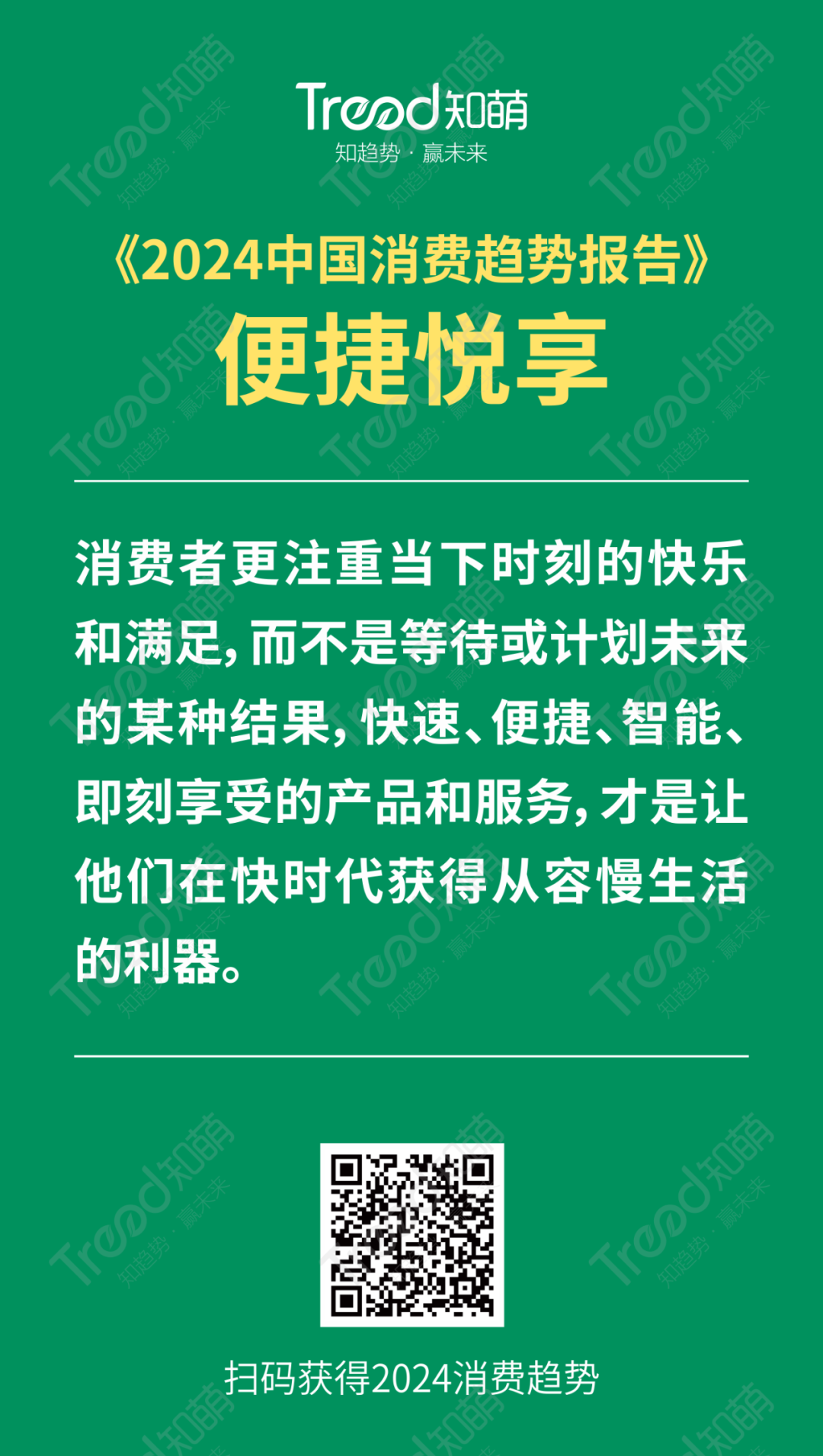
With the acceleration of the pace of life and the convenience brought by technological progress, people’s demand for quick experience and instant enjoyment is constantly emerging, and more and more attention is paid to the consumption value and experience of "unit time". "Delayed satisfaction" has become a past tense, and "I want what I want now" is no longer a slogan, but the normal state of consumption, and this kind of enjoyment of the moment and instant enjoyment has become a key element of self-pleasure. Whether it’s just a trip or an immediate purchase order, Zhimeng’s 2024 China consumption trend survey shows that 73% of consumers think that "instant enjoyment" can bring them a happy mood.
In the fast-paced era, consumers are more pursuing the satisfaction of the present moment. Behind consumers’ demand for convenient life and instant experience, the driving force comes from consumers’ emphasis on efficiency and the reconstruction of time value. In the fast-paced life, 68% consumers want to buy it immediately when they consume, and they are also willing to pay for time-saving products and services; In addition, more than half of consumers hope that after the new product comes out, they can enjoy it first, conveniently and immediately without going out, which has become the pursuit for consumers to enjoy a richer consumption experience.

Consumers’ demand for convenience and enjoyment has also inspired a new retail model-instant retail, which meets the demand for fragmentation through the service model of "store delivery and delivery in half an hour at the earliest", so that the customer experience has been extended in multiple scenes and has become a new growth engine of the retail industry.
According to the report of the Institute of International Trade and Economic Cooperation of the Ministry of Commerce, the scale of China’s instant retail market has reached 504.286 billion yuan in 2022, and it is expected to reach 2,508.265 billion yuan in 2026. With the continuous improvement of the scale and efficiency of the instant delivery system, consumers have gradually formed an instant and enjoyable lifestyle from emergency consumption to instant satisfaction, from "take-away food delivery" to "giving everything away".
Convenience and enjoyment are also further promoting the evolution of "instant commerce". For example, Pot Circle Food Exchange, which was listed at the end of 2023, provides a fourth solution for ordinary people to "eat at home", takes root in the community, standardizes unlimited ingredients through the central kitchen, and screens out "delicious but not expensive" three meals a day. Seven years of commercial exploration ran out of the scale of 10,000 stores, allowing consumers to get more reunions with less cooking time.
In order to make time more valuable, consumers also use all kinds of smart devices to liberate time, make time more meaningful and upgrade their quality of life. Intelligent interactive scenes and products such as voice assistants, smart homes, wearable smart devices, robots (such as sweeping robots) and AI tools have also become the choices of more and more consumers.
For example, X3, a popular hardware product in Iflytek, iFLYTEK Smart Office, has been integrated with the iFLYTEK Spark cognitive model for the first time, and has the ability of open question and answer and multiple rounds of dialogue. It can complete a speech of about 800 words in 20 seconds, which can greatly reduce the work pressure of users, so that everyone can really enjoy the bonus of artificial intelligence and meet the demand for convenience and enjoyment.
Consumers pay more attention to the happiness and satisfaction of the present moment, rather than waiting for or planning a certain result in the future. Products and services that are fast, convenient, intelligent and immediately enjoyed are the sharp weapon for consumers to get a leisurely and slow life in a fast era.
Trend seven essence health
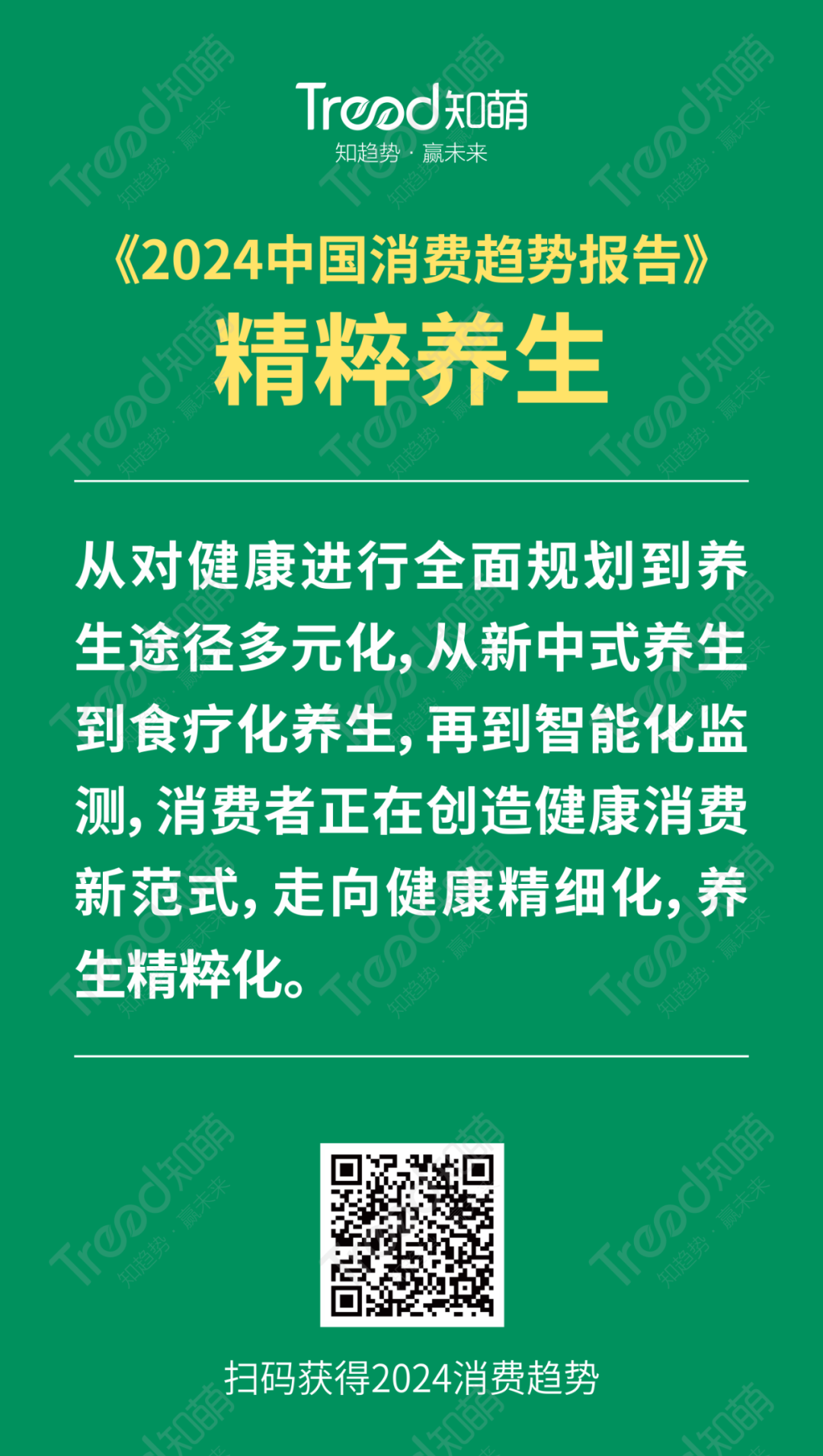
After experiencing a series of public health problems, consumers are increasingly concerned about their own health. Health is no longer "just talking", but moving towards "integration of knowledge and practice". Consumers are actively seeking various health preservation methods to maintain and improve their health level.
Zhimeng’s survey of consumption trends in China in 2024 shows that in 2023, 62.2% of consumers are more concerned about health. From cervical vertebra and lumbar vertebra to sleep, mood, blood pressure, blood sugar and blood lipid to body, hair and respiratory system, consumers pay more attention to health, and the ways of health care also show diversified characteristics, such as adjusting their work and rest habits, eating health care products, exercising, soaking feet before going to bed, drinking health tea, etc. Every generation of consumers has their own "health care book".
What do consumers think is health? Five items of fancy health care were released: going to bed early and getting up early, eating targeted health care products, exercising, soaking feet in hot water before going to bed, and drinking health tea, which also gave birth to a new trend of Chinese health care. Among the hot topics in 2023, "crispy young people" became a hot word, meaning "people who are young but have many problems", which reflected their anxiety and desire for a healthy body, making the heat of health care content continue to rise, and more and more young people joined the Chinese health care army. Soak Lycium barbarum in the left hand, ginseng tea in the right hand, eight brocade in the morning, and massage before going to bed. The consciousness and concept of TCM health care are also constantly infiltrating and popular. Health care tea, health care meals, health care hot pot, and even today’s baked cakes all have health care functions, and many "new Chinese health care" products are constantly emerging.
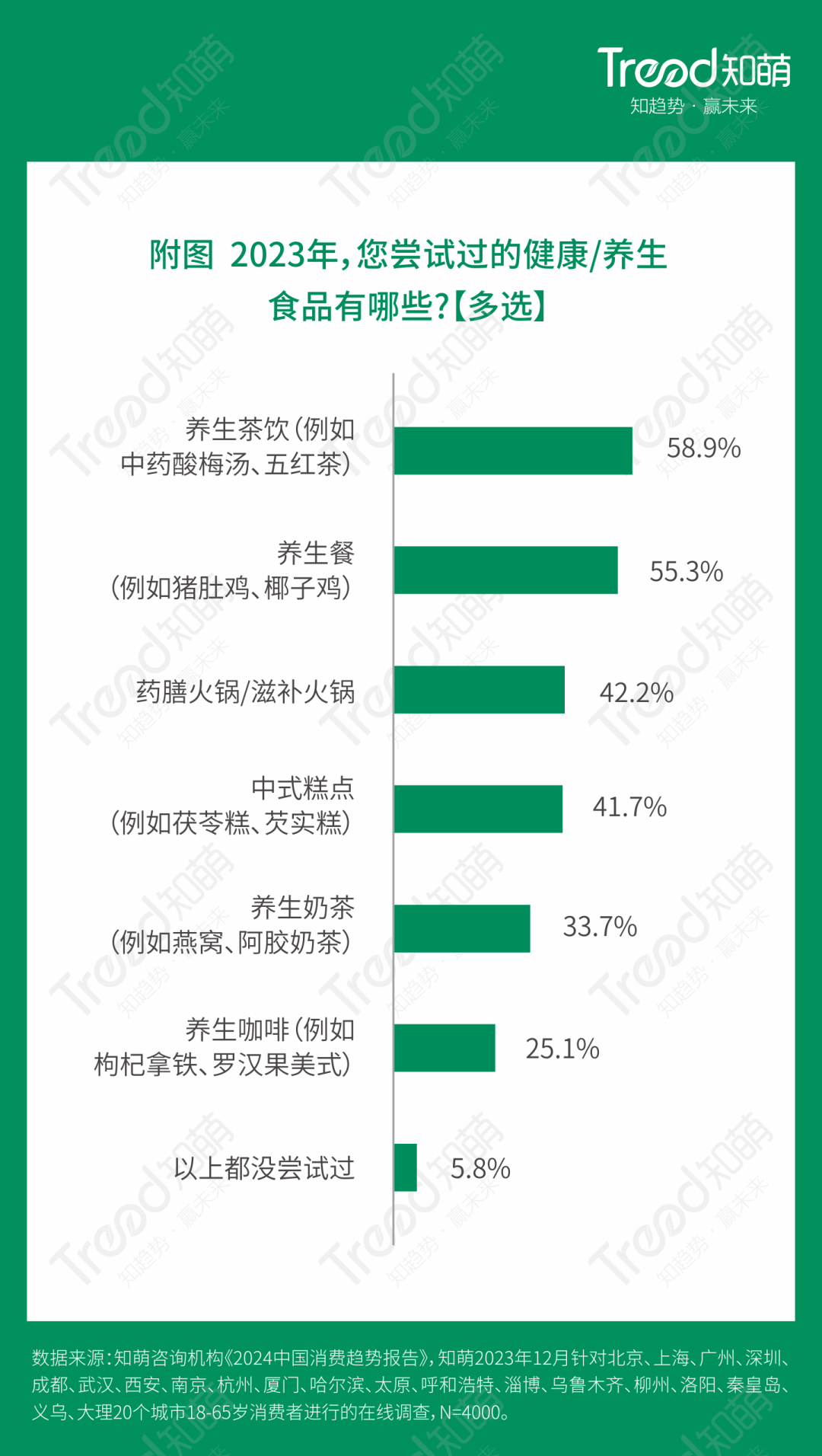
For example, Tongrentang Health Pharmaceutical Co., Ltd. established the brand "Know Your Health" as a sub-brand of the new retail transformation business in 2018, aiming at exploring the younger healthy consumer market and actively exploring the health in the new retail scene of great health.Kang ShengLifestyle. Taiji Huoxiang Zhengqi oral liquid has achieved the best growth performance in history by repositioning it as a "medicine for removing summer heat and dampness". Dong ‘e Ejiao co-branded Naixue tea, which made a cup of "Ejiao milk tea" strong, and launched Dong ‘e Ejiao powder, a "healthy little gold bar", which can be carried around independently, so that Ejiao can also be easily brewed as tea and coffee, which has become a typical case to meet the essence of health care.
The trend of "quintessential health care" has greatly expanded the boundaries of health, broken the boundaries between fast-moving consumer goods and healthy products, matched consumers’ concept of quintessential health care, and brought consumers a sense of freshness and experience.
Trend 8 value reconstruction
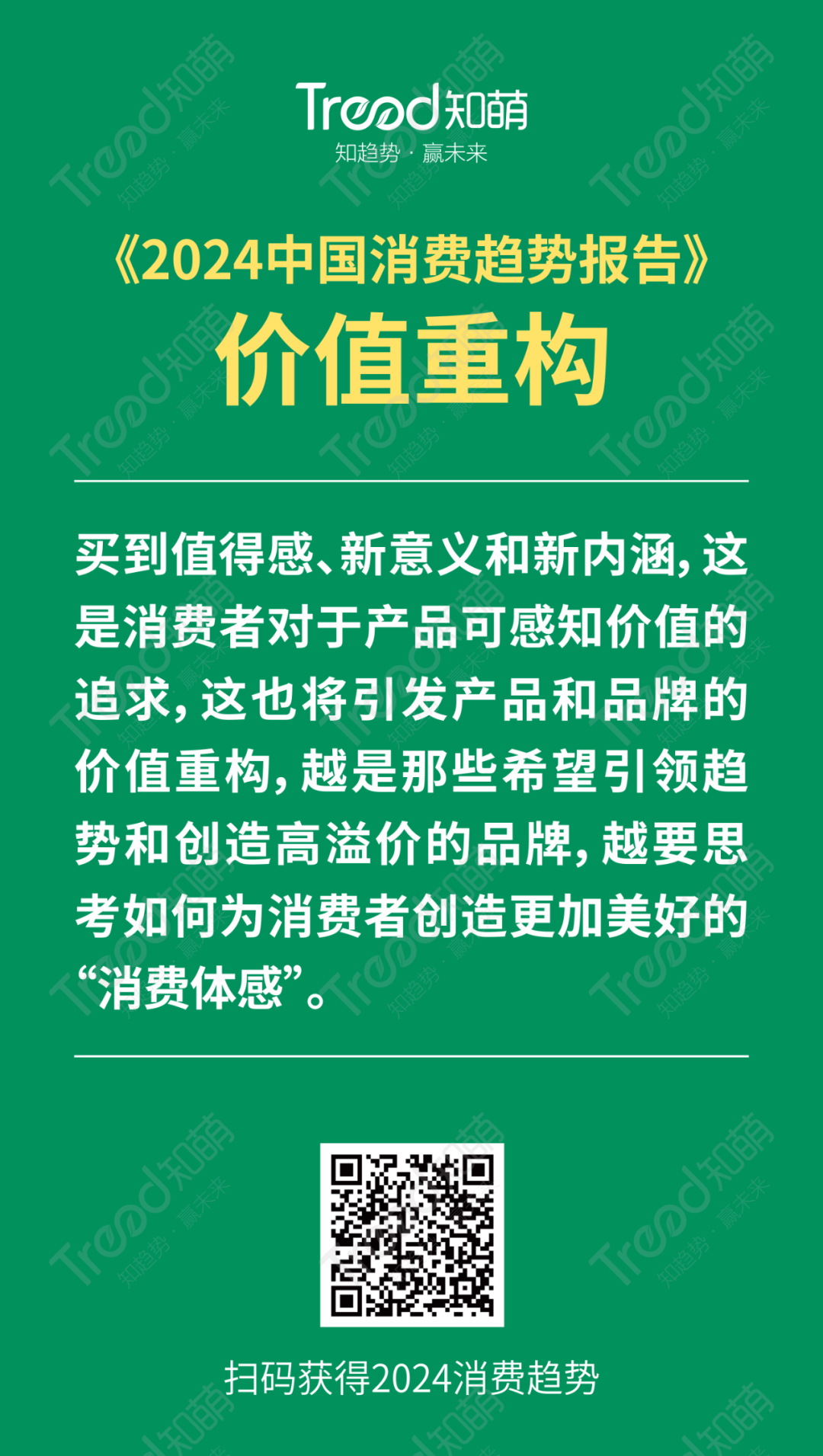
Buying a sense of worth, new meaning and new connotation is the consumer’s pursuit of the perceived value of products, which will also lead to the value reconstruction of products and brands. The more brands that want to lead the trend and create a high premium, the more they should think about how to create a better "consumer sense" for consumers.
Today’s products should define three major markets. Which track should we choose? It is a cost-effective mass parity market; Or create a new experience, a new quality, a price-to-heart market, or a luxury-to-price market that satisfies the sense of scarcity and exclusivity? We must find new value in every market.
The reconstruction of brand value focuses on the improvement of soft power. In the past, it was said that the hard power of products came from functional value, cost performance, selling point and use value. However, brand premium always comes from the promotion of soft power, which is emotional value and experience value.
For example, in the past two years, the popularity of old domestic products has greatly boosted consumers’ cognition and consumption of old national brands, and consumers’ loyalty to national brands has increased year by year. Time-honored brands such as Bee Flower and Vitality 28 have all broken through, and brands and products have made a "rejuvenation" posture in response to new consumer markets and crowds, so as to attract more consumers to reconstruct their value cognition of brands, instead of staying at the inherent traditional cognitive level.
Whether in the market for young people or at the high-end breakthrough level, many brands have made their own way through value breakthrough innovation. For example, Huawei Mate60pro’s new appearance this year is equipped with a new technology of satellite calling function, which brings unprecedented experience to consumers and makes people shine. Haier Zhijia’s high-end brand in casarte focuses on users’ needs, draws a new blueprint for intelligent life, and upholds the core concept of "home art" to create more "consumer value experience" for consumers. When the Z generation becomes the protagonist of social retail consumer goods, Haier Zhijia Leader brand defines the weather vane of "young household appliances" with all-round "cultivating value remodeling", making young people the protagonist of the family.
In what direction will the value upgrade of China brand go in the future? We think that in the future, how to better apply China culture and China aesthetics, how to specialize and go global, and how to apply scientific and technological innovation to enhance hard power are opportunities for value reconstruction.

Value reconstruction is the key means for brands to break the bottleneck of development and break through innovation. We should strive to meet the needs of the market and consumers, continuously improve the perceived value of products, get rid of homogenization, differentiate brands from products, enhance competitive strength, stabilize market share, and make brands achieve a qualitative leap at home and abroad.
Trend nine, no age experience.
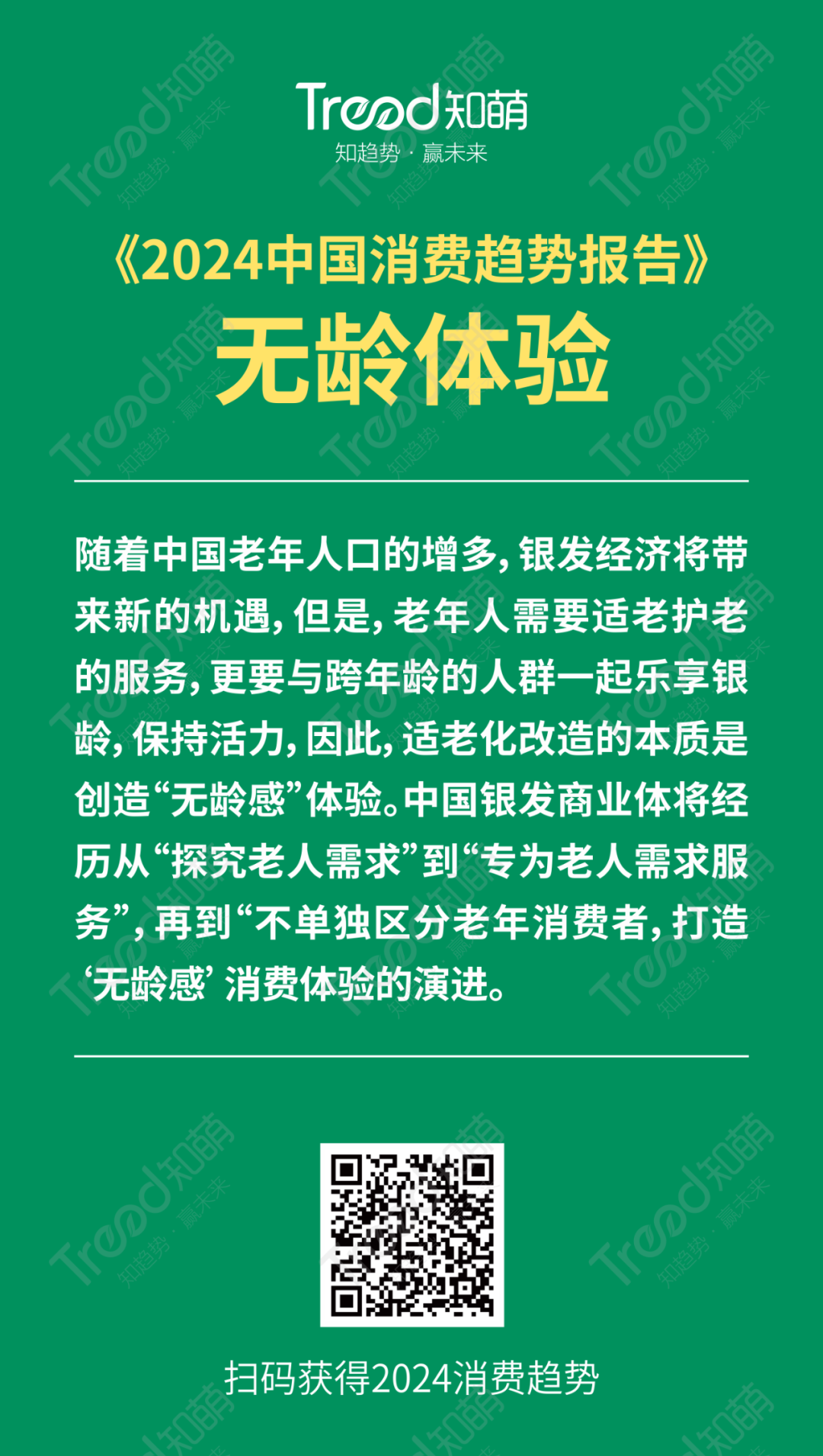
With the increase of the elderly population in China, the silver-haired economy will bring new opportunities. However, the elderly need the service of caring for the elderly, and they should enjoy the silver age and maintain their vitality with the people of different ages. Therefore, the essence of the aging transformation is to create the experience of "no age". China’s silver-haired business body will experience the evolution from "exploring the needs of the elderly" to "serving the needs of the elderly" and then "creating a" sense of youth "consumption experience without distinguishing the elderly consumers separately.
From 2013 to 2022, the proportion of elderly people in China has increased from 9.7% in 2013 to 14.9% in 2022, and the number of elderly people in China will reach 209.78 million in 2022. In the next 10 years, the average age of China’s population and the proportion of the elderly population will also increase rapidly, and the elderly population in China will increase rapidly. According to the United Nations classification standard on aging, China has entered a moderately aging society.
In the future, the market for the elderly will be the "new elderly" market. The people are mainly from the post-60s and post-70s, full of vigor and vitality, and most of them are the generation of "post-80s" and "post-90s" parents. Their needs are developmental and enjoyable. They want to enjoy themselves and compensate themselves. They want to have fun, learn and do things in their old age. Therefore, they prefer to have a sense of age. Therefore, it may become more and more important to adapt to the trend of the elderly, whether to do aging transformation, to do accurate segmentation for the elderly or to do inexperienced experience.

For example, Wrigley and Yue’s barrier-free health bathroom space is a bathroom space specially built by Wrigley Home for the elderly and people with mobility difficulties. It provides specific quality solutions for different use needs and scenarios such as washroom, toilet area and bathing area. For example, the series of Ganmai milk powder for middle-aged and elderly people launched by Danone starts from the aspects of intestinal health and multi-nutrition, aiming at nutritional intervention from the early stage of aging to help healthy aging; In Ya ‘an, Sichuan, there is a So Young nursing home jointly operated by a group of post-90s and post-00s, which has gained popularity with the business philosophy of "providing for the aged and defining the state". Here, the age is blurred between the post-90 s and the post-00 s and the elderly.
Today, we have lived in an ageless society, and everyone should pursue the ageless experience, which may be the key for us to think about the future elderly market.
Trend 10 Sustainable Brand
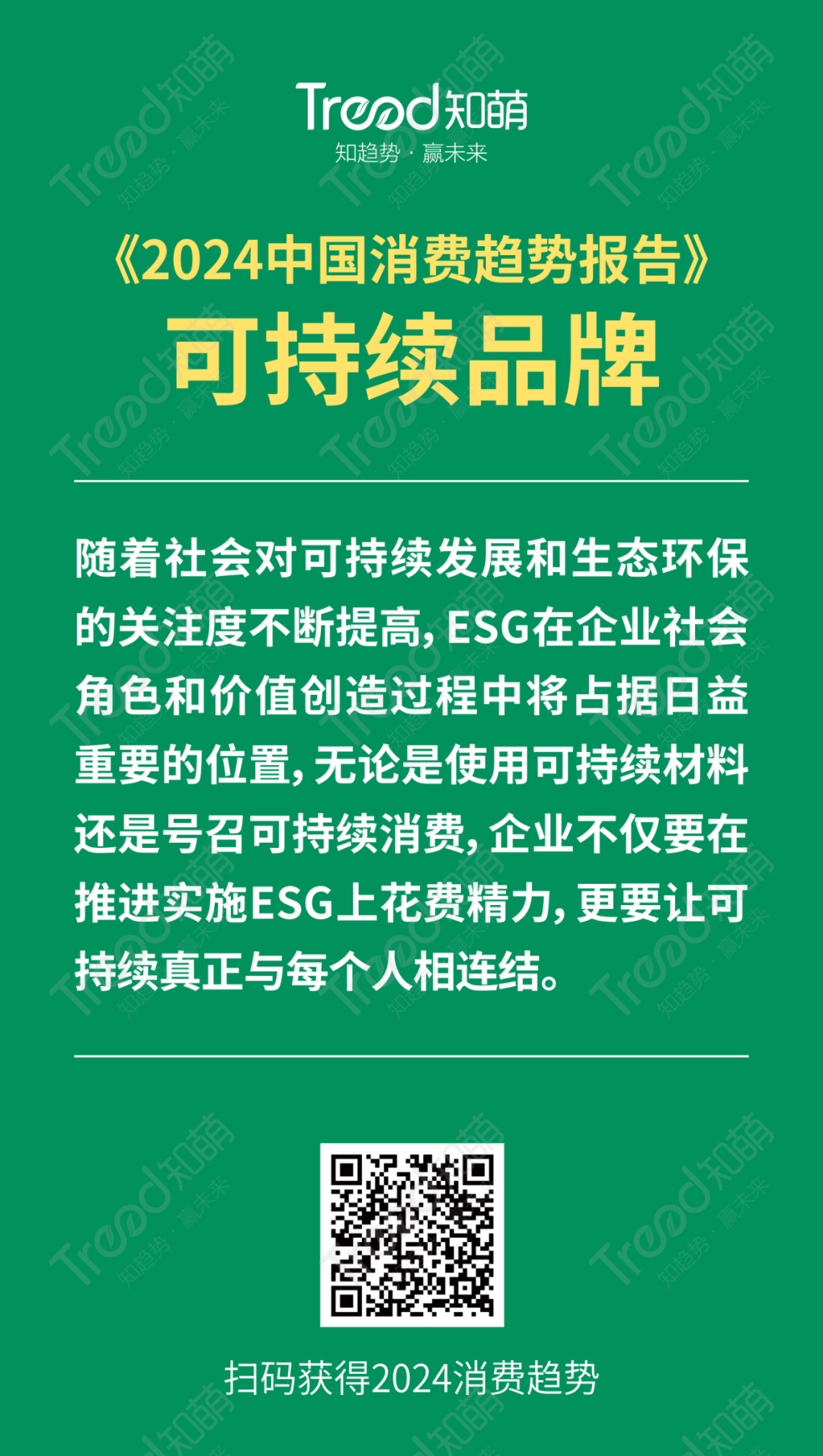
From putting forward the goal of "double carbon" to publishing the peak carbon dioxide emissions Action Plan before 2030 and other heavy documents, the pace of promoting green transformation in China is accelerating. Under the guidance of energy conservation, emission reduction and sustainable development, various industries have shifted their development strategic focus to the direction of green and sustainable development, seeking new economic growth points.
Zhimeng’s survey of China’s consumption trends in 2024 shows that consumers have a high degree of awareness of the concepts related to environmental protection and low carbon, and most consumers have a certain understanding of the concepts related to environmental protection and low carbon, such as "low carbon life", "double carbon goal" and "climate change". More and more consumers will use their own actions to practice practical and reliable actions to reduce carbon and low carbon, such as actively sorting garbage, reusing articles, choosing energy-saving appliances and reducing the use of disposable goods.
Consumers’ awareness of green environmental protection and sustainable development is constantly improving, which also makes consumers gradually change their previous consumption patterns and practice more streamlined and moderate consumption patterns in response to their own support for "carbon reduction" and low-carbon behavior.
Consumers are also paying more and more attention to green, low-carbon and sustainable products and brands. The survey shows that most consumers are more inclined to buy other products of the brand because the products are green or sustainable. Consumers judge whether a product is "green" or "sustainable" on the basis of health and safety, whether to use renewable and recycled materials, whether to save natural resources, environmental protection and whether to use energy resources efficiently.
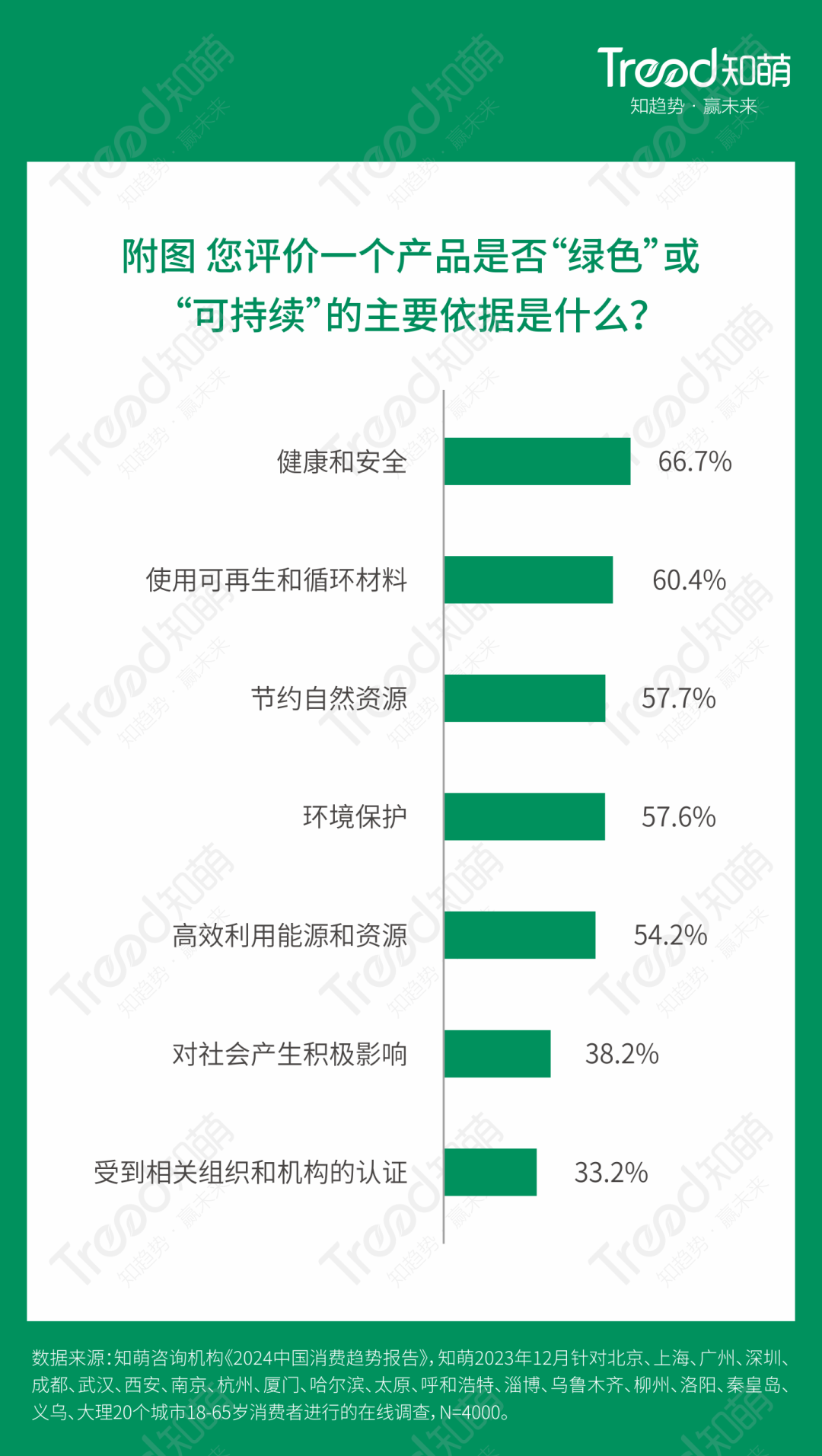
Consumers pay more attention to the concept of sustainable development and social responsibility, and more and more consumers pay more attention to the ESG performance of enterprises. Consumers pay more and more attention to the practical actions taken by enterprises in environmental protection and sustainability, and enterprises that practice the ESG concept will gain more attention and goodwill from consumers.
Many enterprises have taken the lead in implementing sustainability to the level of consumer perception, for example, McDonald’s, which is loved by the public. By extending the concept of green sustainability to every aspect of interaction with consumers, consumers are encouraged to embrace a green lifestyle. Since 2018, McDonald’s China’s first LEED certification (pioneer in energy and environmental design) green building authority certification "Green Restaurant" has settled in xiong’an new area. In five years, McDonald’s China has built more than 2,500 green restaurants, setting a green carbon reduction benchmark for the catering industry. At present, 95% of McDonald’s new stores in China are LEED certified green restaurants. At the same time, McDonald’s China also built the first "zero-carbon restaurant" in China at the drive-through restaurant in Shougang Park of McDonald’s in Beijing. The green restaurant is not only a space for consumers to enjoy McDonald’s delicious food, but also a platform to experience green and embrace a low-carbon lifestyle.
With the society’s increasing attention to sustainable development and eco-environment, ESG will occupy an increasingly important position in the process of corporate social role and value creation. Whether using sustainable materials or calling for sustainable consumption, enterprises should not only spend energy on promoting the implementation of ESG, but also formulate green brand strategies, establish green supply chains, optimize product design and production, and truly connect sustainability with everyone.
